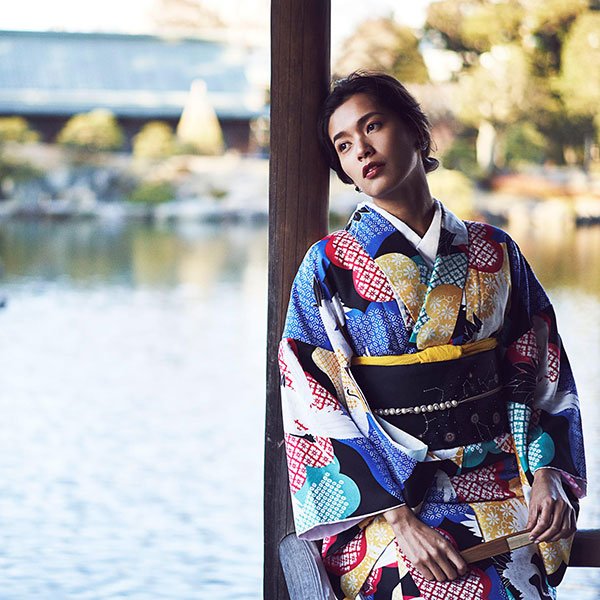Why Kyoto is the World’s Best Place for Craft
by Alicia Joy | TRAVEL
Kyoto was once known as Heian-kyo, and was home to the Imperial Court for over a thousand years. For centuries, arts and culture flourished here, and the city’s craftspeople developed a reputation for superior skill and quality. Discover why many still consider the city to be the unofficial capital of traditional Japanese culture today.
Kyo Yuzen
© Chiso, Yuzen Furisode
Kyo Yuzen was inspired by a dyeing method which came to Japan from China in the 8th century. The method was further developed and popularized during the Edo Period (1603-1868) by an artist known as Miyazaki Yuzensai, whom the technique is named after. Kyo Yuzen was originally applied by painting the fabric by hand, although later stencils began to be used. Crisp lines and patterns are achieved through the use of itomenorioki, a paste obtained from rice which prevents color mixing or bleeding.
Chiso has been perfecting this method of kimono dyeing since 1555, you can find them in most upmarket department stores today, including Takashimaya, Mitsukoshi and Isetan.
Nishijin-Ori
© Hosoo, Nishijin Kimono
Nishijin-Ori is the most sought-after silk-weaving method in Japan for creating fine obi: the long, decorative sashes worn with kimono. The method is named after the Nishijin district of Kyoto where the master artisans first developed and perfected the craft around the year 800. It is a deceptively simple method of creating patterns on silk using dyed threads, which creates a heavy, high-quality fabric that can last for many years.
Kyoto-based weavers Hosoo have been producing fine fabrics since 1688, including for many of the contemporary global fashion houses. If you're in Kyoto, visit their showroom close to the Imperial Palace!
Kunko
© Gryffindor / Wikimedia Commons
Kunko is incense, while the broad term kodo refers to the art of appreciating Japanese incense, from the tools and methods of its creation to the enjoyment of the final product. In the 16th century master of incense Koju developed the konoutoku (Ten Virtues of Incense) while working at the Imperial Palace in Kyoto. Perhaps some of his guidelines should be born in mind by fragrance makers everywhere:
感格鬼神 : Sharpens the senses,
清浄心身 : Purifies the body and spirit,
能払汚穢 : Eliminates pollutants,
能覚睡眠 : Awakens the spirit
静中成友 : Heals loneliness,
塵裏愉閑 : Calms in difficult times,
多而不厭 : It is not unpleasant, even in large amounts,
募而知足 : It is sufficient, even in small amounts,
久蔵不朽 : Does not break down after a long time,
常用無障 : Regular use is not harmful.
Since that time, Kyoto has had a reputation for creating some of the finest incense in Japan.
Kyo-shikki
© Zohiko, Lacquer Decoration
Lacquerware has always been admired for its beauty as well as its usefulness. It was introduced to Japan from China over one thousand years ago. As the Japanese tea ceremony grew more popular lacquerware was frequently commissioned by those at the court in Kyoto for the required tools and accessories. Kyo-shikki came to be known for its fine craftmanship and beautiful design.
Zohiko's reputation for the highest quality lacquerware has been built up since 1661. They have stores in both Kyoto and Tokyo, so why not pay them a visit and see for yourself!
Kyo-yaki
© Cu-Nyo, Kyo-yaki Ceramics
Kyo-yaki, also known as Kyo Ware, is pottery made in Kyoto. It’s an umbrella term that includes all kinds of pottery, from ceramics and stoneware to earthenware and porcelain. Pottery is one of the earliest Japanese crafts, with Kyo Ware believed to have its origins during the 5th century.
Cu Nyo celebrates this centuries-old tradition with its incredibly detailed handcrafted ceramics. Find out more here.
Kyo-sensu & Kyo-uchiwa
© Miyawaki Baisenan, Sensu Folding Fan
The earliest Japanese hand fans (uchiwa) were flat and are believed to have come from China even before the 6th century. But the convenient folding fan (sensu) was invented in Japan shortly after wasn’t picked up by the Chinese until 500 years later. Kyoto sensu and uchiwa are known for their exquisite designs and quality materials, such as lacquer, silk, gold and fine bamboo.
The Kyoto store of Miyawaki Baisenan has the most spectacular selection of handcrafted paper fans and other washi, paper products. If you're looking for authentic Kyoto design, this is a place you should visit!















TRAVEL | December 15, 2023